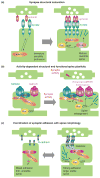Dendritic spine dynamics--a key role for kalirin-7
- PMID: 18597863
- PMCID: PMC3973420
- DOI: 10.1016/j.tins.2008.06.001
Dendritic spine dynamics--a key role for kalirin-7
Abstract
Changes in the structure and function of dendritic spines contribute to numerous physiological processes such as synaptic transmission and plasticity, as well as behavior, including learning and memory. Moreover, altered dendritic spine morphogenesis and plasticity is an endophenotype of many neurodevelopmental and neuropsychiatric disorders. Hence, the molecular mechanisms that control spine plasticity and pathology have been under intense investigation over the past few years. A series of recent studies has improved our understanding of spine dynamics by establishing kalirin-7 as an important regulator of dendritic spine development as well as structural and functional plasticity, providing a model for the molecular control of structural plasticity and implicating kalirin-7 in synaptic pathology in several disorders including schizophrenia and Alzheimer's disease.
Figures




References
-
- Carlisle HJ, Kennedy MB. Spine architecture and synaptic plasticity. Trends Neurosci. 2005;28:182–187. - PubMed
-
- Bourne J, Harris KM. Do thin spines learn to be mushroom spines that remember? Curr Opin Neurobiol. 2007;17:381–386. - PubMed
-
- Alvarez VA, Sabatini BL. Anatomical and physiological plasticity of dendritic spines. Annu Rev Neurosci. 2007;30:79–97. - PubMed
-
- Yuste R, Bonhoeffer T. Genesis of dendritic spines: insights from ultrastructural and imaging studies. Nat Rev Neurosci. 2004;5:24–34. - PubMed
-
- Tada T, Sheng M. Molecular mechanisms of dendritic spine morphogenesis. Curr Opin Neurobiol. 2006;16:95–101. - PubMed
Publication types
MeSH terms
Substances
Grants and funding
LinkOut - more resources
Full Text Sources
Miscellaneous

